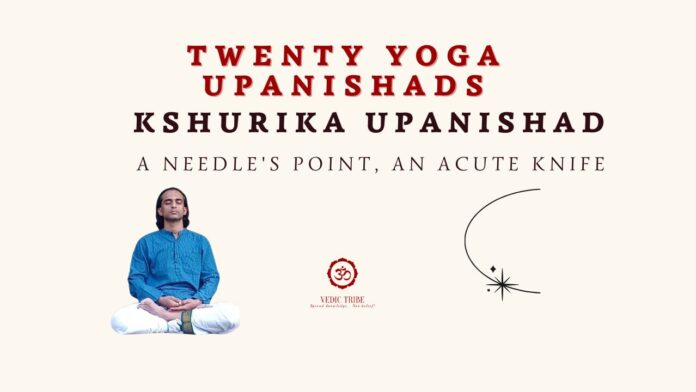What is Kshurika Upanishad?
In the previous article, we discussed Amruta Nadabindu Upanishad and in this article, we will discuss – Kshurika Upanishad.
In this Upanishad, the mind is likened to a razor (Kshurika) that can cut through the bonds of ignorance and attachment. By skilfully directing the mind, one can liberate oneself from the limitations of the ego and experience the true nature of reality.
Movement through Chakras:
Kundalini Yoga: In Kundalini Yoga practice, the energies of the body are moved upward from Muladhara-chakra to Sahasrara Chakra. This is done with the help of regulated BREATHING.
Upanishadic yoga: But in this Upanishad, the MIND is used to cut-through the energy centres i.e., from Muladhara-chakra to Sahasrara Chakra. This process is explained as “Dhyana Yoga” in this Upanishad.
Essentials for practitioners of Dhyana Yoga:
This Upanishad provides a rigid four-point checklist for practitioners of Dhyana Yoga:
Silence: Sadhaka should practice verbal silence. Then all communication via body language should be ceased. Finally mental silence should be attained.
Seclusion: Sadhaka should practice being in seclusion. Seclusion removes all external stimuli and prepares the mind for deep meditation.
Detachment: Sadhaka should detach from all the existing external associations and turn the sense organs inwards.
Indifference: Sadhaka should remain indifferent to all the new external association. This keeps the mind composed and focused on the meditative practices.
Dhyana Yoga, or meditation, is not merely a passive exercise. When perfected, it becomes a dynamic and transformative process. It is a process of activating, purifying, and transcending Chakras through concentrated awareness. Here the tool is not the breath, but the mind itself. Since regulation of mind is very difficult, a rigid four-point checklist is provided in the Upanishad.
With this, the Dhyana Yoga becomes a powerful practice where one can pierce through the energy centres in the body and attain spiritual liberation.
Simplified Dhyana Yoga in Bhagavad Gita:
In Bhagavad Gita, Lord Krishna simplifies the ancient “Dhyana Yoga” practice and gives a 5 step process:
Seclusion: Sadhaka should reside in seclusion, continually engaged in meditation with a regulated mind and body, getting rid of desires and belongings for enjoyment (6.10)
Asana: Sadhaka should be seated on grass, cloth or deer skin (currently illegal), which is neither too high nor too low. (6:11)
Gaze: Sadhaka should hold the body, neck, and head firmly in a straight line, and gaze at the tip of the nose, without allowing the eyes to wander (6:13)
Celibacy: Sadhaka should practice celibacy (6:14)
Meditation upon Parabrahman: Sadhaka must contemplate Parabrahman (6.14)
Key takeways:
– If you are a beginner in meditative practices, Dhyana Yoga explained by Lord Krishna is an ideal place to start.
– Once you progress in your spiritual journey, you may adopt Dhyana Yoga explained in Kshurika Upanishad.
In the next article, we will discuss – “Tejobindu Upanishad”.
Madhwesh K
Vedic Tribe

